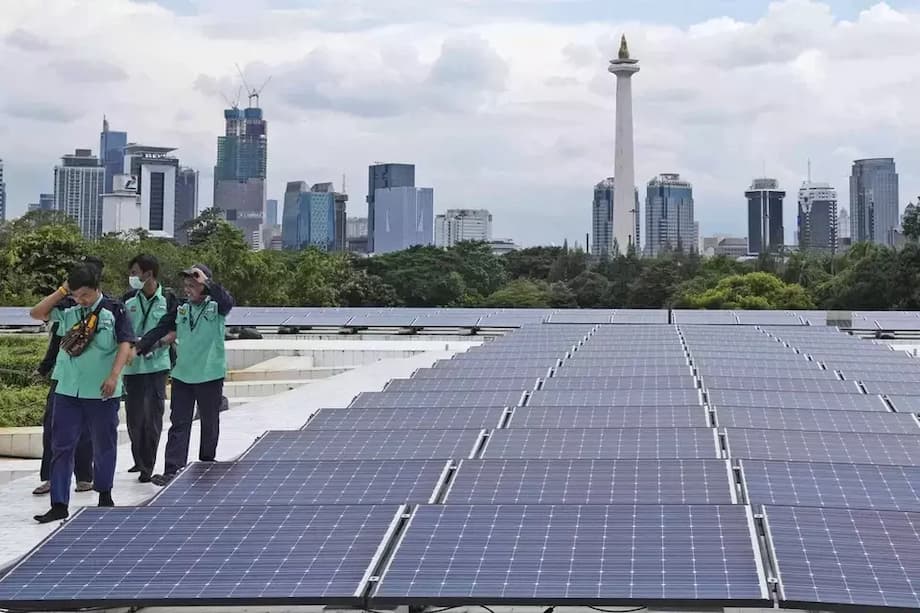Indonesia at the center of a global clean energy contest
Indonesia, the world’s largest coal exporter, has become the focal point of a high stakes race to replace coal with cleaner power. The contest features the United States and China, and it will shape not only Indonesia’s energy system but also the rules and suppliers that many developing countries may follow. Chinese companies signed more than 54 billion dollars in agreements in 2023 with PLN (the state owned utility), and a visit to Beijing in 2024 by President Prabowo Subianto added another 10 billion dollars in commitments. These figures dwarf a 20 billion dollar Just Energy Transition Partnership agreed in 2022 with a group of wealthy countries. The partnership has been slow to move money, and the US formally withdrew from it in March. Only about 1.2 billion dollars, roughly 6 percent of the pledged amount, has been disbursed. Jakarta estimates the full transition will require more than 97 billion dollars. The choice presented to Indonesia is stark. Washington promotes liquefied natural gas as a reliable bridge fuel and a way to reduce reliance on Chinese technology. Beijing offers massive investment in renewables and factories that can create jobs at speed, with fewer conditions on labor and the environment. The outcome will set the direction for Indonesia’s electricity prices, air quality, and industrial growth for decades.
- Indonesia at the center of a global clean energy contest
- Two paths on offer: gas or a renewables industrial push
- What the Just Energy Transition Partnership can still do
- China’s footprint from mines to gigafactories
- The costs of coal, nickel, and captive power
- LNG deals, tariffs, and energy security
- Indonesia’s strategy to keep agency and attract capital
- Regional dynamics and new partners
- What success could look like by 2030
- The Bottom Line
Why Indonesia matters
Demand for electricity in Indonesia is rising with a growing population and expanding industry. Coal remains a major economic pillar, contributing an estimated 3.6 percent of gross domestic product. Yet solar and wind power are still a tiny part of the mix, around 0.24 percent of total energy. Neighboring countries are further along, at about 3.8 percent in the Philippines and 13 percent in Vietnam. Indonesia’s choices in the next few years carry extra weight because power plants last a long time and because political cycles are five years. Decisions taken now will either lock in more fossil infrastructure or accelerate deployment of renewables and storage.
Two paths on offer: gas or a renewables industrial push
Two models are on the table. One centers on gas imports and a more traditional approach to energy security. The other centers on renewables and a deep manufacturing footprint in batteries, electric vehicles, and solar panels. Each path comes with costs and benefits for Indonesia’s economy, its environment, and its freedom to set policy.
The US offer: gas and geopolitics
The US is the world’s top oil and gas producer, and it has encouraged Indonesia to expand liquefied natural gas purchases as part of wider talks on tariffs and trade. Indonesia plans to boost LNG imports from the US by around 10 billion dollars. Proponents say gas can displace coal in the near term, lower local air pollution, and firm up the grid when the sun is not shining and the wind is not blowing. Critics worry that new LNG terminals, pipelines, and gas power plants could entrench fossil fuel use and leave Indonesia with outdated assets as renewable power becomes cheaper and faster to deploy. There is also an industrial dimension. Washington is trying to secure critical minerals and clean technology supply chains among partners that meet higher standards, which can complicate cooperation when Chinese firms dominate parts of Indonesia’s mining and processing sector.
The China offer: speed and scale in renewables
China’s approach focuses on large scale renewables and industrial supply chains. The offer is straightforward. Replace imported fossil fuels with solar panels and other equipment that produce electricity for decades. Build factories that turn nickel and other minerals into batteries and cars. Train workers and move quickly. This is attractive for leaders who want visible progress within a five year term. It also comes with trade offs. Chinese projects tend to be fast and capital intensive, but they often have fewer safeguards for labor rights and local environments, and they can bring new coal dependencies through captive power in smelter parks.
What the Just Energy Transition Partnership can still do
The Just Energy Transition Partnership was never meant to cover Indonesia’s full bill. It is a starting platform that combines grants, concessional loans, and guarantees to catalyze more capital. The partnership pledged 20 billion dollars, with the US portion at about 2 billion dollars, roughly half of which remains accessible through loan guarantees. Only 1.2 billion dollars has moved so far, and the US exit in March hurt momentum at the political level. Even so, the partnership can still help align projects that reduce coal use, modernize the grid, and bring in new financiers beyond the US and Europe.
From high expectations to practical projects
Early discussions set expectations that were hard to meet. A reset toward concrete, bankable projects is under way. Priorities include early retirement of the most polluting coal units, upgrades to transmission lines that allow more solar and wind to connect, and fast tracking of utility scale and rooftop solar with clear rules for tariffs and procurement. The partnership also served as a coordination hub, helping Indonesia open doors to new partners from the Gulf. Deals with the United Arab Emirates and Saudi Arabia are among the avenues for more long term, lower cost capital. If Indonesia uses the partnership to fix permitting bottlenecks and improve contract terms, the same platform can still unlock substantial private investment.
China’s footprint from mines to gigafactories
China’s presence in Indonesia’s clean energy economy runs from resource extraction to final assembly. A 6 billion dollar supply chain venture by battery champion CATL aims to integrate mining, processing, and battery production. BYD is building a 1 billion dollar electric vehicle plant with planned capacity of 150,000 cars a year and an estimated 18,000 jobs. BTR New Material Group is investing 478 million dollars in battery materials. Solar giant LONGi is setting up a factory with annual capacity of around 1.6 gigawatts. On the power side, delivery speed is a selling point. In 2024, a 100 megawatt solar park built by a Chinese engineering firm went from groundbreaking to operation in about seven months. That pace fits Indonesia’s political timetable, although many Western investors offer stronger safeguards on labor and the environment.
China’s depth in manufacturing and procurement often means lower prices and shorter timelines. For Indonesia, local content rules can harness this scale to build domestic supply chains and skills. The key question is how much local value is created and whether environmental standards inside industrial parks match national laws. Clear targets for Indonesian suppliers, worker training, and disclosure of pollution data can turn fast delivery into durable development gains.
The costs of coal, nickel, and captive power
Most nickel mines and smelters in Indonesia operate with dedicated coal plants that sit behind the meter. These captive units provide reliable power for energy hungry processing, yet they lock in emissions and local pollution. A study in 2024 estimated that pollution from smelters and coal fired power plants would cost the Indonesian economy about 2.6 billion dollars in 2025, rising to 3.4 billion dollars by 2030, with thousands of premature deaths. Those external costs, which do not appear on company balance sheets, fall on communities and public health budgets.
Indonesia still has the third highest amount of coal power capacity in the world, and new plants remain in the pipeline. About 1.9 gigawatts of recent additions were largely for smelter complexes, and roughly 80 percent of that capacity serves captive needs for mineral processing. Building more coal, even for industrial parks, runs the risk of stranded assets as lenders and customers tighten rules on carbon intensity. If the government pairs smelter development with renewable power purchase contracts and storage, it can begin to switch these industrial clusters away from coal without sacrificing output.
LNG deals, tariffs, and energy security
Indonesia’s plan to increase LNG imports from the US by around 10 billion dollars sits inside a broader negotiation on trade and tariffs. LNG can help stabilize the grid and cut local pollutants compared with coal. It also emits greenhouse gases, and it requires expensive infrastructure and long term purchase commitments. If global gas prices spike, or if solar, wind, and storage undercut gas on price, Indonesia could be stuck with higher costs. The risk is a lock in to fossil assets that outlast their competitiveness.
Trade politics shape these energy choices. US rules on electric vehicle tax credits favor materials from allied sources and with higher environmental and labor standards. Chinese firms control a large share of Indonesia’s nickel refining capacity, estimated at around three quarters. Washington has raised concerns about how this affects supply chain access to US incentives. One path under discussion is to develop dedicated investment zones that meet stricter standards and ownership structures. Indonesia is seeking exemptions from new US tariffs and looking for tradeoffs that include more imports of US energy and agricultural products. The balancing act is delicate, yet it gives Jakarta leverage to press both sides for better financing, technology transfer, and market access.
Indonesia’s strategy to keep agency and attract capital
Indonesia’s longstanding approach is to avoid alignment with any single power and to keep many investment channels open. That stance, often described as a thousand friends and zero enemies policy, is now being applied to the energy transition. The government has pursued industrial downstreaming by banning raw nickel ore exports, nudging investors to build processing plants onshore. It is expanding local content rules and seeking trade deals that open doors to the largest markets. The aim is to climb the value chain and keep strategic autonomy while decarbonizing at a pace that fits domestic realities.
Near term priorities
Several moves can maximize Indonesia’s bargaining power and clean energy gains. First, accelerate grid upgrades, especially in areas with the best solar and wind resources, and publish a transparent pipeline of transmission projects. Second, run competitive tenders for utility scale solar, wind, and storage with clear tariffs, standardized contracts, and predictable permitting. Third, replace captive coal units at smelters with dedicated renewable power purchase contracts, backed by storage and flexible grid services. Fourth, enforce stronger pollution standards and continuous monitoring in industrial parks, with public disclosure. Fifth, set up worker transition programs in coal regions to create dignified jobs in new industries. Sixth, align public finance, including any JETP and New Development Bank funds, with early coal retirement, grid modernization, and distributed energy in remote islands.
Policy certainty will be just as important as money. Investors watch the integrity of contracts, the independence of regulators, and the ability of PLN to honor purchase agreements. Clear rules on land, environmental impact assessments, and local content will reduce project delays. Publishing timelines and data on interconnection queues, resource quality, and curtailment will help developers price risk. The government can also set targets for domestic manufacturing of solar modules, batteries, and grid equipment, while keeping the door open to international suppliers to avoid shortages and price spikes.
Regional dynamics and new partners
Indonesia is not navigating this alone. Southeast Asia is one of the fastest growing energy markets, and the region is drawing investment in renewables and grids. China has financed major power links, such as interconnections that move surplus hydropower from mainland Southeast Asia. Australia is backing projects to export clean electricity to the region, including a proposed link that would send solar power to Indonesia and Singapore. These efforts, if paired with regional power trading and better grid planning, can lower costs and smooth variability in supply.
Diversification is also visible in trade and finance. Indonesia is deepening ties with Japan, South Korea, India, the European Union, and Gulf countries. Entry into the Brics group opens access to the New Development Bank, which could support green infrastructure with more flexible terms than some traditional lenders. US relations remain important for security, investment, and digital trade. At the same time, Jakarta continues to affirm international law at sea while managing complex relations with Beijing. The mix of partners reduces overreliance on any single source of capital or technology.
What success could look like by 2030
By 2030, success would show up in a power system that is cleaner, cheaper to run, and more reliable. Solar, wind, and storage would expand from a fraction of the mix to several percentage points of total generation, multiplied many times from today’s base. The most polluting coal units would be retired early or run less often, and new captive coal projects would give way to renewable contracts inside industrial parks. The grid would have new lines that unlock high quality solar and wind zones, with clear interconnection rules. Indonesia would have at least a few large battery factories and one or more electric vehicle plants running near full capacity, with a growing share of components made domestically. Health costs linked to air pollution around smelters and coal plants would fall, as continuous monitoring and stricter standards take hold. Most of all, investors would see a predictable policy environment that rewards delivery against national targets while protecting workers and communities.
The Bottom Line
- China’s energy and manufacturing investments in Indonesia outsize Western pledges and move faster to completion.
- The Just Energy Transition Partnership has disbursed only a small share of promised funds but still offers a platform for practical projects.
- Indonesia estimates it needs more than 97 billion dollars to shift its power sector onto a cleaner path.
- The US approach favors LNG and supply chain rules that align with higher environmental and labor standards.
- Indonesia plans to increase LNG imports from the US by about 10 billion dollars as part of broader trade talks.
- Chinese firms are embedded across the supply chain, from nickel to electric vehicles, and control much of Indonesia’s refining capacity.
- Captive coal plants powering smelters carry rising economic and health costs and risk becoming stranded as clean power costs fall.
- Major Chinese backed projects include investments by CATL, BYD, BTR New Material Group, and a LONGi solar plant.
- Power sector choices now will shape energy prices, air quality, and industrial competitiveness for decades.
- Clear rules, faster grids, competitive procurement, and stronger safeguards can help Indonesia keep agency while attracting capital from all partners.




